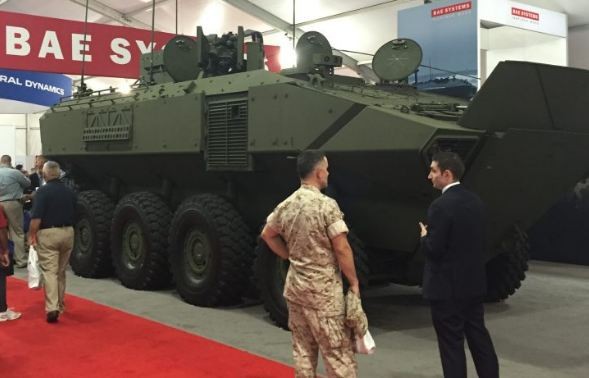US Marines’ New Amphibious Combat Vehicle will be a Monster
| Arthur Dominic Villasanta | | Oct 04, 2016 12:06 AM EDT |
(Photo : BAE) BAE ACV
One of the two models competing for the right to become the next generation amphibious armored personnel carrier of the U.S. Marines is a huge beast taller than an M1 Abrams main battle tank and almost as fast.
The test vehicle called "SuperAV" produced by BAE Systems and Italy's IVECO Defence for the Marines' Amphibious Combat Vehicle (ACV) program weighs nearly 34 tons and can swim using its eight wheels.
Like Us on Facebook
It stands 2.74 meters tall compared to the M1 Abrams it will accompany into battle with a height of 2.44 meters. SuperAV can also tear across land at 112 km/h after being launched from amphibious assault ships such as those of the America-class. The ACV's role is to partner the Abrams in amphibious assaults on enemy beaches and during the breakout from these footholds.
This vehicle produced as part of the program's ACV 1.1 iteration combines superior protection with amphibious and land capabilities. The ACV 1.1 might join the Marine Corps' Assault Amphibious Vehicle fleet in the future.
The Marines use the AAV-7A1 amphibious assault vehicle to move from ship to shore. The AAV-7A1 has been in service for 45 years.
ACV 1.1 will provide Marines with far better protection against IEDs and landmines, as well as protection from aerial threats. The design for this assault vehicle includes integrated armor for MRAP-level protection.
In 2015, the Marines awarded contracts to BAE Systems worth $104 million and to SAIC worth $122 million for the Engineering, Manufacturing and Development phase of the ACV 1.1 program. SAIC is working on their ACV version called the Terrex 1.
BAE Systems will produce 16 prototypes the Marine Corps will test. The Marine Corps will decide whether to proceed with the SuperAV or the Terrex 1 in 2018.
A winner should be selected in 2018 to build 204 vehicles, with the first entering service in 2020 and all delivered by 2023.
TagsU.S Marines, Amphibious Combat Vehicle, M1 Abrms, BAE Systems, IVECO Defence, saic, Terrex 1
©2015 Chinatopix All rights reserved. Do not reproduce without permission
 Destroying China’s Militarized Islands will take about 15 Minutes, says Former US Spy Chief
Destroying China’s Militarized Islands will take about 15 Minutes, says Former US Spy Chief US to Sharpen Military Edge in Asia; Duterte Planning to Turn the Philippines Communist?
US to Sharpen Military Edge in Asia; Duterte Planning to Turn the Philippines Communist? US Navy's Anti-Torpedo Torpedo Protects Aircraft Carriers from Submarine Attack
US Navy's Anti-Torpedo Torpedo Protects Aircraft Carriers from Submarine Attack US Generals Confident in F-35’s Ability to Defeat Russian and Chinese Fighters in Air Combat
US Generals Confident in F-35’s Ability to Defeat Russian and Chinese Fighters in Air Combat
EDITOR'S PICKS
-

Did the Trump administration just announce plans for a trade war with ‘hostile’ China and Russia?
-

US Senate passes Taiwan travel bill slammed by China
-

As Yan Sihong’s family grieves, here are other Chinese students who went missing abroad. Some have never been found
-

Beijing blasts Western critics who ‘smear China’ with the term sharp power
-

China Envoy Seeks to Defuse Tensions With U.S. as a Trade War Brews
-

Singapore's Deputy PM Provides Bitcoin Vote of Confidence Amid China's Blanket Bans
-

China warns investors over risks in overseas virtual currency trading
-

Chinese government most trustworthy: survey
-

Kashima Antlers On Course For Back-To-Back Titles
MOST POPULAR
LATEST NEWS
Zhou Yongkang: China's Former Security Chief Sentenced to Life in Prison

China's former Chief of the Ministry of Public Security, Zhou Yongkang, has been given a life sentence after he was found guilty of abusing his office, bribery and deliberately ... Full Article
TRENDING STORY

China Pork Prices Expected to Stabilize As The Supplies Recover

Elephone P9000 Smartphone is now on Sale on Amazon India

There's a Big Chance Cliffhangers Won't Still Be Resolved When Grey's Anatomy Season 13 Returns

Supreme Court Ruled on Samsung vs Apple Dispute for Patent Infringement

Microsoft Surface Pro 5 Rumors and Release Date: What is the Latest?










